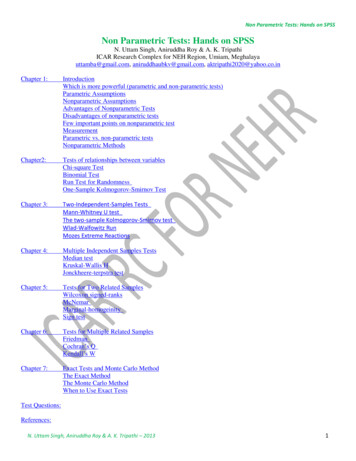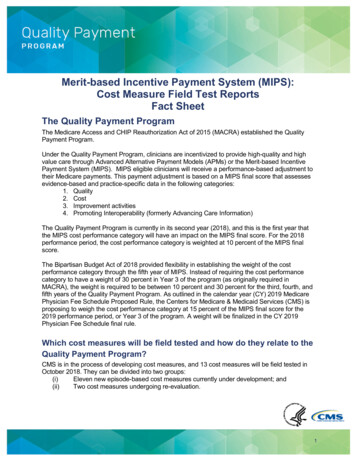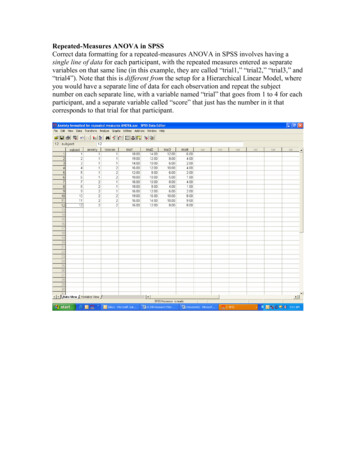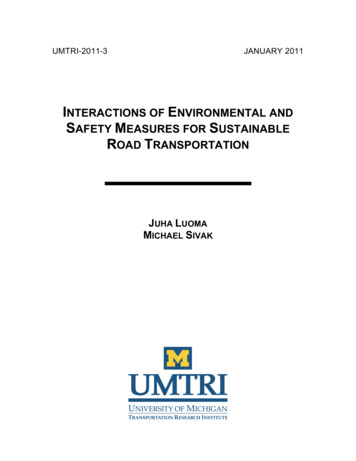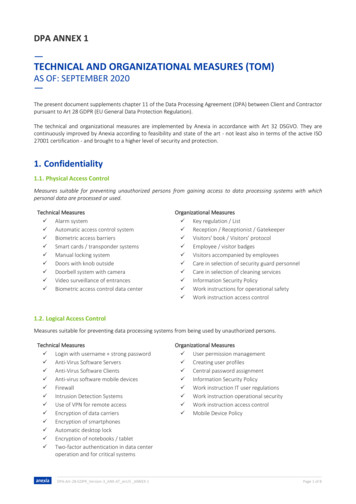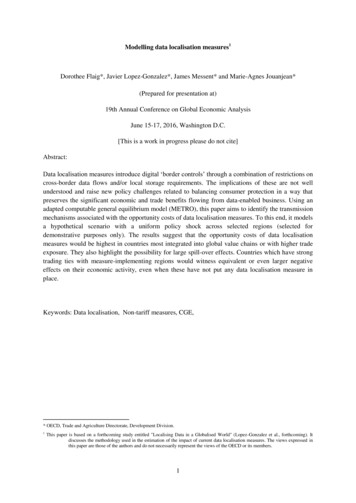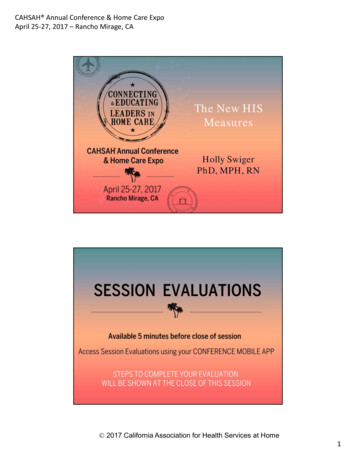
Transcription
CAHSAH Annual Conference & Home Care ExpoApril 25‐27, 2017 – Rancho Mirage, CAThe New HISMeasuresHolly SwigerPhD, MPH, RN 2017 California Association for Health Services at Home1
CAHSAH Annual Conference & Home Care ExpoApril 25‐27, 2017 – Rancho Mirage, CAObjectives Review the current HIS reportingrequirements Understand he two new quality measuredetails Explain the four new HIS discharge dataitems3HQRP Hospice Quality Reporting Program ismandated by Section 3004(c) of theAffordable Care Act of 2010– Pay for reporting– Public reporting4 2017 California Association for Health Services at Home2
CAHSAH Annual Conference & Home Care ExpoApril 25‐27, 2017 – Rancho Mirage, CAHQRP Since Fiscal Year (FY) 2014, the Secretaryshall reduce the Annual Payment Update(APU) by 2% for a hospice that does notcomply with the quality data submission5HIS Data SubmissionRequirements6 2017 California Association for Health Services at Home3
CAHSAH Annual Conference & Home Care ExpoApril 25‐27, 2017 – Rancho Mirage, CAHQRP Reporting RequirementsTo comply with FY 2019 requirements, hospiceproviders must: Submit at least 80% of all Hospice Item Set(HIS) records within 30 days of the event(patient’s admission or discharge) foradmissions & discharges occurring 1/1/17 to12/31/17 Have an ongoing monthly participation in theConsumer Assessment of Healthcare Providersand Systems (CAHPS) Hospice Survey by anapproved third-party vendor, whom submitsdata quarterly7Reporting Requirements All Medicare hospice providers with activeCNN number (provider number) mustreport Hospices awaiting certification will beexpected to have HIS processes in place atthe time of their initial survey for deemedstatus Must report both admission and dischargeHIS reports for all admissions8 2017 California Association for Health Services at Home4
CAHSAH Annual Conference & Home Care ExpoApril 25‐27, 2017 – Rancho Mirage, CAReporting Requirements Providers are required to begin reportingdata on the date noted on their CCNnotification letter. However, if the CCN notification letter wasdated on or after November 1st, theywould not be subject to any financialpenalty for failure to comply with HQRPrequirements for the relevant reportingyear.CMS HIS Q & A October 20169Reporting Requirements HIS data is collected and submitted on allpatient admissions, regardless of thepatient’s:– Payer– Age– Location of receipt of hospice services (home,NF, ALF, GIP)– Length of stay– Transfers from another hospice10 2017 California Association for Health Services at Home5
CAHSAH Annual Conference & Home Care ExpoApril 25‐27, 2017 – Rancho Mirage, CAFlowchart for Patient Admission11Data Collection HIS data can be collected:– By the assessing clinician in conjunction withpatient assessment activities– By abstraction from the patient’s clinical record Data can be collected/abstracted by one ormore members of the hospice team:––––NurseSocial WorkerAideVolunteer12 2017 California Association for Health Services at Home6
CAHSAH Annual Conference & Home Care ExpoApril 25‐27, 2017 – Rancho Mirage, CAHIS Review A review must be completed to ensurecompleteness of the entire HIS– Individuals who completed any part of theHIS must sign in Z0400 Attesting to accuracy– Individuals who review for completeness mustsign Z0500 Only attesting to completeness Not attesting to accuracy of other hospice teammembers responses13Data Collection Hospices submit HIS data to CMS throughthe Quality Improvement and EvaluationSystem (QIES) Assessment Submissionand Processing (ASAP) system.14 2017 California Association for Health Services at Home7
CAHSAH Annual Conference & Home Care ExpoApril 25‐27, 2017 – Rancho Mirage, CAHIS Data Submission To submit records into the QIES ASAPsystem, Hospice providers need:– CMSNet User ID and password.– Juniper software installed.– QIES User ID and password.– HIS record in the proper electronic fileformat.15HIS Recommended Completion &Submission DeadlinesAdmission HISDischarge HIS (Due toDeath, Discharge orRevocation)HIS Admission RecommendedCompletion Deadline AdmissionDate 14 calendar days(Admission day day 0)HIS Discharge RecommendedCompletion Deadline DischargeDate 7 calendar days(Completion of abstraction of HISwithin 7 days of discharge)HIS Admission Record SubmissionDeadline Admission Date 30calendar daysHIS Discharge Record SubmissionDeadline Discharge Date 30calendar days16 2017 California Association for Health Services at Home8
CAHSAH Annual Conference & Home Care ExpoApril 25‐27, 2017 – Rancho Mirage, CAData Submission Timelines HIS Records SUBMITTED does not meanthat the HIS Records are ACCEPTED!! All HIS Records must be successfullyaccepted by the QIES ASAP system within30 calendar days of the event date17HIS Final Validation Reports The FVR is available in the ValidationReport folder in the CASPER Reportingapplication. A link to the CASPER Reportingapplication is available on the Welcome tothe CMS QIES Systems for Providers Webpage.18 2017 California Association for Health Services at Home9
CAHSAH Annual Conference & Home Care ExpoApril 25‐27, 2017 – Rancho Mirage, CAHIS Submission ThresholdCalculation19HIS Quality MeasuresNQFMeasure NameNQF #1641Treatment PreferencesNQF #1647Beliefs/Values Addressed (if desired by patient)NQF #1634Pain ScreeningNQF #1637Pain AssessmentNQF #1639Dyspnea AssessmentNQF #1638Dyspnea TreatmentNQF #1617Patients Treated with an Opiod who are Given a Bowel RegimenNAHospice & Palliative Care Composite Process Measure –Comprehensive Assessment at AdmissionNAHospice Visits When Death is Imminent Measure Pair20 2017 California Association for Health Services at Home10
CAHSAH Annual Conference & Home Care ExpoApril 25‐27, 2017 – Rancho Mirage, CAAdmission HIS21New Items for the Admission HISRequired for Admissions on or after 4/1/20171.2.3.4.A0550: Zip codeA1400: Payor InformationJ0905: Pain Active ProblemHospice and Palliative Care Quality CompositeMeasure22 2017 California Association for Health Services at Home11
CAHSAH Annual Conference & Home Care ExpoApril 25‐27, 2017 – Rancho Mirage, CACurrent Issues on Identification ofAdministrative Information23Current Issues on Identification ofAdministrative InformationUse the name as it appears on the Medicare Card24 2017 California Association for Health Services at Home12
CAHSAH Annual Conference & Home Care ExpoApril 25‐27, 2017 – Rancho Mirage, CANew Item on Identification ofAdministrative Information25Current Issues on Identification ofAdministrative InformationCheck all that apply, according to the patient/family!26 2017 California Association for Health Services at Home13
CAHSAH Annual Conference & Home Care ExpoApril 25‐27, 2017 – Rancho Mirage, CACurrent Issues on Identification ofAdministrative Information27Payor InformationResponse J – Self Pay:Should be selected if the patient has anyamount of personal funds available tocontribute to healthcare expenseResponse K – No Payor Source:Should be selected if the patient does not haveany of the payor sources in response to optionsA-I available, nor do they have any personalfunds available to contribute to healthcareexpenses. 2017 California Association for Health Services at Home14
CAHSAH Annual Conference & Home Care ExpoApril 25‐27, 2017 – Rancho Mirage, CAPayor InformationResponse X – Unknown:Should be selected if the patient is notconfirmed to have any of the above payorsources in response options A-KResponse Y – Other:Should be selected if the patient has availableone or more payor sources that is not listed inresponse options A-K.NQF #1641 Treatment PreferencesNumerator – Patient stays from thedenominator where the patient/responsibleparty was asked about preference regarding useof cardiopulmonary resuscitation, orhospitalization, or other life-sustainingtreatments no more than 7 days prior toadmission or within 5 days of the admissiondate.Denominator - All patient stays, except thosewith exclusions. Patients under 18 areexcluded.30 2017 California Association for Health Services at Home15
CAHSAH Annual Conference & Home Care ExpoApril 25‐27, 2017 – Rancho Mirage, CACurrent Issues in Section F:PreferencesScenario 1 – Date of Admission – 7/1/16 – 7/1/16 Clinical record for the patientincludes a DNR order, signed by patient 6/15/16.Scenario 2 - Date of Admission – 7/1/16 – 7/3/16 Nurse assessment checked box,“Patient wants comfort care”.31Current Issues in Section F:PreferencesScenario 3– Date of Admission – 7/1/16 – 7/1/16 Nurse Assessment Note states,“Talked with patient and caregiver about preferences for readmission to hospital.Patient was hesitant and said they weren’t sure. Told patient that we could discussthis further on a future visit.32 2017 California Association for Health Services at Home16
CAHSAH Annual Conference & Home Care ExpoApril 25‐27, 2017 – Rancho Mirage, CANQF #1641 Beliefs/ValuesAddressedNumerator – Number of patient staysfrom the denominator where the patientand/or caregiver was asked aboutspiritual/existential concerns no more than7 days prior to admission or within 5 days ofthe admission date.Denominator - All patient stays, exceptthose with exclusions. Patients under 18 areexcluded.33Current Issues in Section F:Beliefs/Values AddressedScenario 1 – Date of Admission 8/1/16 – SW Assessment Note dated 8/2/16 –“ Patient’s spouse in a great deal of spiritual distress and wants to speak with chaplain.Referral made.Scenario 2 - Date of Admission 8/1/16 – Nurse Assessment Note dated 8/1/16 –Patient identified as Baptist.34 2017 California Association for Health Services at Home17
CAHSAH Annual Conference & Home Care ExpoApril 25‐27, 2017 – Rancho Mirage, CACurrent Issues in Section I:Active Diagnoses Do not use external sources for your response This is your hospice primary diagnosis Even if your primary diagnosis changes during their stay on hospice, you do notupdate this35NQF #1634 Pain ScreeningNumerator - Patient stays from thedenominator who are screened for thepresence or absence of pain and, if present,rating of its severity using a standardizedtool within 2 days of admission to hospice.Denominator - All patient stays except forthose with exclusions. Patients under 18 areexcluded.36 2017 California Association for Health Services at Home18
CAHSAH Annual Conference & Home Care ExpoApril 25‐27, 2017 – Rancho Mirage, CACurrent Issues in Section J:Health Conditions37Types of Standardized Pain ToolUtilized Numeric – Examples of standardized numeric scalesinclude but are not limited to, 10- point scale, theSymptom Distress Scale (McCorkle), the MemorialSymptom Assessment Scale (MSAS), and theEdmonton Symptom Assessment System (ESAS). Verbal Descriptor – Examples of standardizedverbal descriptor scales include, but are not limited to,the Brief Pain Inventory, the McGill painquestionnaire, and the 6- Point Verbal Pain Scale. 38 2017 California Association for Health Services at Home19
CAHSAH Annual Conference & Home Care ExpoApril 25‐27, 2017 – Rancho Mirage, CATypes of Standardized Pain ToolUtilized Patient Visual - Examples of standardized patientvisual scales include, but are not limited to, the WongBaker FACES Pain Scale, a visual analog scale, and adistress thermometer. Staff Observation - Examples of standardized staffobservation scales include, but are not limited to, theCritical Care Pain Observation Tool (CPOT), theChecklist of Nonverbal Pain Indicators (CNPI), thePain Assessment Checklist for Seniors with LimitedAbility to Communicate (PACSLAC), and PainAssessment in Advanced Dementia (PAIN-AD).39Current Issues in Section J:Health Conditions40 2017 California Association for Health Services at Home20
CAHSAH Annual Conference & Home Care ExpoApril 25‐27, 2017 – Rancho Mirage, CAPain Active Problem (J0905)All patients should be screenedfor pain.Should be in the initial assessment and bebased on patient specific findings.If pain is identified at the time of admission oras an active problem there should be acomprehensive assessment.What Qualifies as an Active PainProblem?Consider factors beyond pain severity at thetime of the encounter: Historical report of pain or reports of recentsymptomsCurrent treatment for pain with scheduled or prnmedicationsIt is possible that the clinician maydetermine pain is an active problem forthe patient, even if pain is not presentduring the clinical encounter. 2017 California Association for Health Services at Home21
CAHSAH Annual Conference & Home Care ExpoApril 25‐27, 2017 – Rancho Mirage, CAWhat Qualifies as an Active PainProblem?E-Kit Comfort Kits and pre-printed admission orders alone areinsufficient evidence to determine pain is an activeproblem. “Treatment” is not considered initiated until there is anorder and there is documentation that the patient/caregiverwas instructed to begin using the medication. Pro-active education on medications in a comfort kit inanticipation of symptoms alone is insufficient evidence todetermine pain is an active problem.Old Version of Pain Screening44 2017 California Association for Health Services at Home22
CAHSAH Annual Conference & Home Care ExpoApril 25‐27, 2017 – Rancho Mirage, CANew J0900 – Pain ScreeningRevisedSequenceNQF #1637 Pain AssessmentNumerator - Patient stays from the denominatorwho received a comprehensive pain assessmentwithin 1 day of the pain screening and the painassessment included at least 5 of the followingcharacteristics: location, severity, character,duration, frequency, what relieves or worsens thatpain, and the effect on function or quality of life.Denominator - Patients stays, except for thosewith exclusions, where the patient’s pain severityat the pain screening was rated mild, moderate, orsevere. Patients under 18 are excluded.46 2017 California Association for Health Services at Home23
CAHSAH Annual Conference & Home Care ExpoApril 25‐27, 2017 – Rancho Mirage, CAComprehensivePain AssessmentFor inclusion in the newcomposite measure:1.If applicable, acomprehensive painassessment must occurwithin 1 day of the positivepain screen, and1.Include at least five ofthe seven paincharacteristics.ComprehensivePain Assessment for Non-Verbal Patients A caregiver report about any of the abovecharacteristics is acceptable. Clinical notesabout assessment of nonverbal indicators ofpain for any of the above characteristics arealso acceptable.48 2017 California Association for Health Services at Home24
CAHSAH Annual Conference & Home Care ExpoApril 25‐27, 2017 – Rancho Mirage, CAComprehensivePain Assessment for Non-Verbal Patients Nonverbal indicators of pain include nonverbalsounds such as crying, whining, and groaning;facial expressions, such as grimacing andclenching jaws; and protective body movementsor postures such as bracing, guarding, rubbing,or clutching a body part. For example:– An assessment that included pain location for anonverbal patient may include documentation, such as“patient grimaced and shouted when clinician touchedtheir right leg” or other documentation denoting patientexhibiting nonverbal cues of pain for a specific locationon the body.49ComprehensivePain Assessment for Non-Verbal Patients- An assessment that included pain severity for anonverbal patient may include documentationabout intensity of nonverbal expressions of pain(grimaces, winces, and clenched teeth/jaw) orprotective body movements (bracing, guarding,rubbing, clutching, or holding of a certain bodypart/area). It could also include documentation ofseverity using a nonverbal standardized rating scale.- Character will not be able to be assessed on apatient as it is a descriptor by the patient.50 2017 California Association for Health Services at Home25
CAHSAH Annual Conference & Home Care ExpoApril 25‐27, 2017 – Rancho Mirage, CAComprehensivePain Assessment for Non-Verbal Patients- An assessment that included pain durationfor a nonverbal patient may includedocumentation about how long a patientexhibits any nonverbal cues of pain, such as“patient cradled right arm throughout entirevisit.”- An assessment that included pain frequencyfor a nonverbal patient may includedocumentation about how often a patientexhibits any nonverbal cues of pain, such asmost of the time, only at night, intermittently.51ComprehensivePain Assessment for Non-Verbal Patients– An assessment that included whatrelieves/worsens pain for a nonverbal patientmay include documentation about actions,activities, or positions that relieve/worsen pain,such as “patient exhibits fewer nonverbal signs ofpain when sitting up versus lying down.”– An assessment that included pain’s effect onfunction or quality of life for a nonverbalpatient may include documentation about change inpatient activity, such as “family caregiver reportsthat patient is no longer able to sit up in bed withoutmoaning.”52 2017 California Association for Health Services at Home26
CAHSAH Annual Conference & Home Care ExpoApril 25‐27, 2017 – Rancho Mirage, CAComprehensivePain Assessment for Non-Verbal PatientsFor any of the seven characteristics included inthe pain assessment, select response optionsbased on whether the clinician made anattempt to gather the information from thepatient/caregiver. For example, if, for a nonverbal patient, theclinician asked the family/caregiver about painlocation and the family/caregiver responded “I’m notsure” or “I don’t know,” “1, Location” should bechecked for J0910C because the clinician attemptedto gather the information.53NQF #1639 Dyspnea ScreeningNumerator – Percentage of patient staysduring which the patient was screened fordyspnea during the initial nursingassessment.Denominator - All patient stays except forthose with exclusions. Patients under 18 areexcluded.54 2017 California Association for Health Services at Home27
CAHSAH Annual Conference & Home Care ExpoApril 25‐27, 2017 – Rancho Mirage, CACurrent Issues in Section J:Health Conditions – Respiratory StatusAlways have a reason to answer YES!Always assess!!!55Current Issues in Section J:Health Conditions – Respiratory StatusScenario 13/5/17 Clinical Note – “Patient very drowsy; appears to be comfortable during visit.”Scenario 23/5/17 Clinical Note – “Patient reports no discomfort and is breathing shallowly butwithout signs of distress; no concerns about breathing from patient or family.”56 2017 California Association for Health Services at Home28
CAHSAH Annual Conference & Home Care ExpoApril 25‐27, 2017 – Rancho Mirage, CANQF #1638 Dyspnea TreatmentNumerator – Patient stays from thedenominator who received treatment within1 day of screening positive for dyspnea.Denominator - Patient stays, except thosewith exclusions, where the patient screenedpositive for dyspnea at the initial screeningencounter. Patients under 18 are excluded.57Current Issues in Section J:Health Conditions – Dyspnea Treatment58 2017 California Association for Health Services at Home29
CAHSAH Annual Conference & Home Care ExpoApril 25‐27, 2017 – Rancho Mirage, CANQF #1617 Bowel Regime forOpioidsNumerator – Patients from thedenominator that are given a bowel regimenor there is documentation as to why this wasnot needed.Denominator - Patient stays, except forthose with an exclusion, where a scheduledopioid that is initiated or continued. Patientsunder 18 are excluded.59Current Issues in Section N:Medications60 2017 California Association for Health Services at Home30
CAHSAH Annual Conference & Home Care ExpoApril 25‐27, 2017 – Rancho Mirage, CACurrent Issues in Section N:Medications61Current Issues in Section N:Medications This is only if the patient has a scheduled or prn opioid ordered. Don’t forget treatments such as non pharmaceutical measures such asincreasing fluids, prune juice, etc.62 2017 California Association for Health Services at Home31
CAHSAH Annual Conference & Home Care ExpoApril 25‐27, 2017 – Rancho Mirage, CACurrent Issues in Section N:MedicationsScenario –3/24/17 Orders –Oxycodone 10 mg POevery 4 hours, PRN forpain.3/24/17 Clinical Note –Patient has diarrhea.63Composite Process Measure –Comprehensive Assessment at AdmissionActive for Discharges on or after 4/1/2017Numerator – All patient stays from thedenominator who meet the numerator criteria forthe individual component QMs applicable to thepatient.Denominator - All patient stays, except forthose with exclusions. Patients under 18 areexcluded.64 2017 California Association for Health Services at Home32
CAHSAH Annual Conference & Home Care ExpoApril 25‐27, 2017 – Rancho Mirage, CAHospice and Palliative CareComposite Process MeasureThis measure will provide consumers and providerswith: A single measure regarding the overall quality andcompleteness of assessment of patient needs athospice admission. A measure that can be used to meaningfully andeasily compare quality across hospice providers. A measure that sets a higher standard of care forhospices.Hospice and Palliative CareComposite Process Measure This Quality Measure reports the percentage ofhospice patients who received all seven HIS careprocesses for which they are eligible at admissionto a hospice. The measure is calculated using data from existingHIS-Admission items. No new data collection willbe required for this measure. Patient admissions occurring on or after April 1,2017, will be included in the measure calculation. 2017 California Association for Health Services at Home33
CAHSAH Annual Conference & Home Care ExpoApril 25‐27, 2017 – Rancho Mirage, CAHospice and Palliative CareComposite Process MeasureHospice and Palliative CareComposite Process MeasureExclusions:Discharge data with no admission dataPatients Under 18. Data will still be collected, butwill not be calculated in the composite score.A major change to the measure specificationsas part of the NQF endorsement was removalof the length of stay (LOS) criterion; all sevenmeasures now have no LOS exclusion. 2017 California Association for Health Services at Home34
CAHSAH Annual Conference & Home Care ExpoApril 25‐27, 2017 – Rancho Mirage, CADischarge HIS69Discharge HISActive for Discharges on or after 4/1/2017Section O: Service Utilization(Hospice Visits When Death is imminent)CMS goal of increasing care in the last weekof life and eventually reporting it publically.70 2017 California Association for Health Services at Home35
CAHSAH Annual Conference & Home Care ExpoApril 25‐27, 2017 – Rancho Mirage, CASection O: Service UtilizationPaired Measure #1Numerator – Number of patients from thedenominator receiving at least one visit fromregistered nurses, physicians, nursepractitioners or physician assistants in the last3 days of life.Denominator - All patients, except for thosewith exclusions. Patients are excluded from thedenominator if the patient did not expire inhospice care or the patient received anycontinuous home care, respite care, or generalinpatient care in the last 3 days of life.71Discharge Quality Measures Applies to patients discharged due to death. Patients who had GIP, CC or Respite during theperiod of review are excluded. Phone calls are not counted. Post-Mortem visits are not counted. Visits provided to the patient’s family may becounted. Patients under 18 are not excluded. 2017 California Association for Health Services at Home36
CAHSAH Annual Conference & Home Care ExpoApril 25‐27, 2017 – Rancho Mirage, CAVisits in the Last 3 Days of LifeAssesses the percentage of patients receivingat least one visit from the followingdisciplines: Registered Nurses Physicians Nurse Practitioners or Physician AssistantsVisits in the Last 3 Days of Life 2017 California Association for Health Services at Home37
CAHSAH Annual Conference & Home Care ExpoApril 25‐27, 2017 – Rancho Mirage, CASection O: Service UtilizationPaired Measure #2Numerator – Number of patients from thedenominator receiving at least two visits from medicalsocial workers, chaplains or spiritual counselors,licensed practical nurses or hospice aides in the last 7days of life.Denominator - All patients, except for those withexclusions. Patients are excluded from thedenominator if the patient did not expire in hospicecare or the patient received any continuous home care,respite care, or general inpatient care in the last 7 daysof life, or had a length of stay of one day.75Visits in the Last 7 Days of LifeAssesses the percentage of patients receivingat least two visits from the followingdisciplines: Medical Social Workers Chaplains or Spiritual Counselors LVNs Hospice Aides 2017 California Association for Health Services at Home38
CAHSAH Annual Conference & Home Care ExpoApril 25‐27, 2017 – Rancho Mirage, CASection O: Service UtilizationPaired Measure #277Section O: Service UtilizationPaired Measure #278 2017 California Association for Health Services at Home39
CAHSAH Annual Conference & Home Care ExpoApril 25‐27, 2017 – Rancho Mirage, CASection O: Service UtilizationPaired Measure #2 Three days prior to death is calculated asA0270 (Discharge Date) minus 3. Four days prior to death is calculated asA0270 minus 4. Five days prior to death is calculated asA0270 minus 5. Six days prior to death is calculated asA0270 minus 6.7980 2017 California Association for Health Services at Home40
CAHSAH Annual Conference & Home Care ExpoApril 25‐27, 2017 – Rancho Mirage, CASection Z: Record Administration81Section Z: Record Administration82 2017 California Association for Health Services at Home41
CAHSAH Annual Conference & Home Care ExpoApril 25‐27, 2017 – Rancho Mirage, CACASPER Hospice Level QualityMeasure Report83HIS Collection & Submission Who will be doing the abstraction? Will it be individual staff, QAPI staff,managers? Who will be responsible to review forcompleteness and sign the Z0500? Who will submit the data? Who will review the Final Validation Reportand follow up on Fatal Errors or RejectedRecords?84 2017 California Association for Health Services at Home42
CAHSAH Annual Conference & Home Care ExpoApril 25‐27, 2017 – Rancho Mirage, CAHIS Summary Know & meet the timelines for completion& submission Ensure that staff complete all 7 assessments Reinforce confusing areas and teach newHIS data to be collected Be sure your EMR calculations are correct Report in XML format Track you’re HIS data in Casper Follow the CMS Quarterly HIS Q & As85ReferencesFY 2017 Hospice Final lity-reporting.The Hospice Item Set y-Reporting/HospiceItem-Set-HIS.html.Hospice Quality lityReporting/index.html. 2017 California Association for Health Services at Home43
CAHSAH Annual Conference & Home Care ExpoApril 25‐27, 2017 – Rancho Mirage, CAResources Hospice User Guides and Training:https://www.qtso.com/hospicetrain.html CMS HQRP Reporting/index.html Quality Help Desk:HospiceQualityQuestions@cms.hhs.gov Technical Help DeskHelp@qtso.com or (877) 201-4721 (Monday-Friday 7:00 a.m. - 7:00p.m. Central Time)87ResourcesListservs: MLN Connects /subscriber/new?pop t&top ic id USCMS 7819 ODF treach/OpenDoorForums/ODFHHHDME.html Federal Register: http://www.federalregister.gov‒ Review proposed and final rules88 2017 California Association for Health Services at Home44
CAHSAH Annual Conference & Home Care ExpoApril 25‐27, 2017 – Rancho Mirage, CAThank You!Questions?89Session SponsorVisit Sponsor at Booth # 112!90 2017 California Association for Health Services at Home45
CAHSAH Annual Conference & Home Care ExpoApril 25‐27, 2017 – Rancho Mirage, CASpeaker InformationHolly Swiger PhD, MPH, RNOwner/Lead ConsultantStellar Concepts, Inc.37760 Sky High Drive951-203-9600951-927-9318hswiger@me.com92 2017 California Association for Health Services at Home46
-CMSNet User ID and password. -Juniper software installed. -QIES User ID and password. -HIS record in the proper electronic file format. 16 HIS Recommended Completion & Submission Deadlines Admission HIS Discharge HIS (Due to Death, Discharge or Revocation) HIS Admission Recommended Completion Deadline Admission Date 14 calendar days



